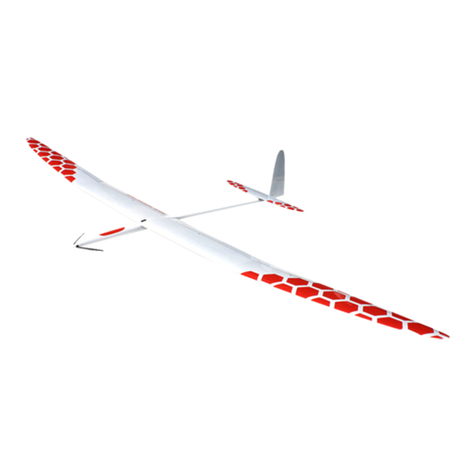•Install the threads and clevises whilst the servo arms are set 90 degrees on the
servos and the ailerons / flaps are set in neutral position. Secure the thread to the
clevis with extra thin CA as this is a place with some slop. Check also thoroughly
the clevis pins going into the horns and servo arms. There are clevises that can be
poorly made in this special detail. Use the inner most hole on the servoarms
possible to ensure full power of the servo yet providing full throw.
•It is recommended to install clear tape on the ends of the wings. This will prevent
the paint being ripped off when the tape is applied / removed every time you go
flying.
•Adjust the aileron throw to 20/12mm.
•Adjust the aileron throw on flaps to 9/6mm
•Adjust the crow brake flaps to as much as possible (70-85 degrees is good)
•Adjust the crowbrake on ailerons to 7mm up
•Adjust the camber for launch to 10mm flap and aileron equal.
Camber for thermal is +3mm measured on flaps and equal along the whole
trailing edge. More thermal camber might be used in special weather conditions.
Camber/relex for speed is -1 mm.
•Snap flap (elevator – flap mix) can be used up to 10mm on full elevator throw.
Beware snap flap might not be the most effective in all conditions / flying styles.
•Cut the servo covers carefully so that the servo horns fit underneath the bumps if
needed.
Assembling the fuselage:
•Install the “fuse to wing”-harness in the fuselage. Roughen the green connector
and fuselage fitting before you glue it.
•Install the receiver battery and receiver before servos. 2+2 AA batteries are
recommended though 2+3 can also be fitted. It is recommended to pack the
receiver in bubble plastic or equal to absorb shocks.
Two Lion battery is possible. Ensure servos can use the voltage and secure the
front end of the battery to absorb shocks. Use a voltage regulator if needed.
•Install the fuselage servos
•Install the receiver. If 2.4 receiver with long antennas is used there is a slot on
the underside of the inner nose cone to tape on one antenna. Drill a hole so that
the antenna comes out without making a sharp bend. Tape the antenna to the
inner nose cone. The second (or more) antenna is taped on the receiver side
making sure it is as free as possible and not hidden by electronics or wires.
The outer nose cone is of glassfiber and signals will pass thru with no hindering. A
range test will show that your installation is correct.
•Shorten the rod for correct length. Roughen inside of the tube and glue the
coupler inside of the push rod. Pinch the coupler with a plier to ensure tight fit.
Check the connection thoroughly.
Glue the pushrod tube to the fuselage between canopy and the leading edge
•Adjust the elevator so that it is in neutral checking top and bottom airfoil. Full
throw is 5mm up and 5mm down. At full crow the elevator goes down
approximately 5mm depending on crow settings for wing. It is good to ensure
more down throw (+10mm) possible after crow brake is set.
Launch setting is -1mm
Rudder throw +/- 6mm
Assembling the model:
•Attach the two v-tails to the fuse and secure with a tiny piece of tape round the
front and lower part. Carefully push the ball link in place and check that they
move freely. Pinch the plastic with a plier to free them up if they are tight. The





















